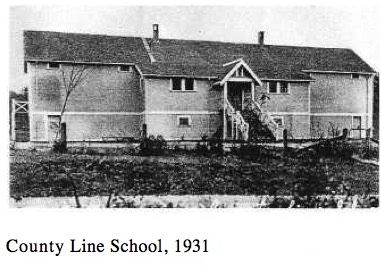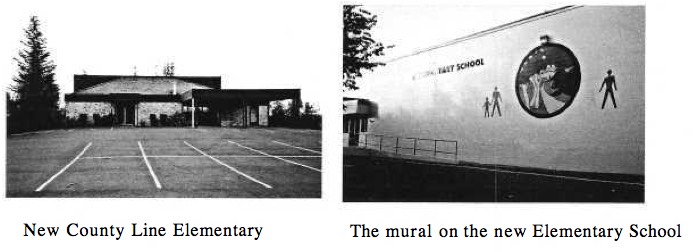In the 1890s County Line Elementary started out as Beaver Elementary, a one-room school located at the corner of Coghlan (256) and Roberts (56) Roads. In 1918 a new and larger school was built half a mile east on Roberts Road, and at this time its name was changed from Beaver School to County Line Elementary.
This new school was a two-storey building with kerosene lamps and a wood furnace in the basement. Outhouses were built over a swamp which meant the students had to walk through water to reach the toilets. In 1931 the school burned down. According to local reports, the insurance money helped to build Willoughby Elementary.
County Line 1931Early teachers at this school were Mr. Roy Mountain, Mr. Sangster, and Mrs. Effie Mary Bilton. Mrs. Bilton was known as a strict disciplinarian who taught folk dancing and arranged large Christmas concerts. She also had a large pointer which was used on occasion to rap knuckles.
After the fire of 1931 a new County Line Elementary was built on the site. In 1935 night classes in manual training were held at the school, and gas lamps were purchased for use at this time.
The building was two storeys high, with no windows in the front and was painted pink. The classrooms were on the second floor. The only redeeming feature was a rather grand entrance, a wide stairway leading to the front door on the second floor. There were three classrooms with a hall which served as cloakroom. A fourth room was later constructed in the basement area at the west end for a woodworking shop. The basement was all open on the south side and had a gravel floor. This served as a play area in wet weather. However, it was also used to store firewood, restricting the play area in early fall and expanding as the wood was burned. The three classrooms were similar except the rooms at each end had a door and fire escape on the end wall. The whole south side was window from about four feet above the floor. The windows were about twelve feet high, opening from both the bottom and top by means of a long pole. They provided the only source of light and the main ventilation.
When you entered the rooms, you were assailed by the smell of the linseed oil used on the floors and the smell of varnish on the walls (beaver board with narrow battens over the joints). The other three walls were blackboards. In the middle of the room was a large black barrel stove with a sheet metal fence around it. It was a cavernous monster which gobbled up a number of four-foot lengths of cordwood at a time. There was no insulation in the walls. The desks were cast iron frames with wooden tops and seats. They were mounted on 2 x 4 skids, a row of three desks together which could be shifted around. The water supply came from a dug well at the back of the school, but the well often went dry or produced brown smelly water, swimming with ants and red wiggly creatures. Fortunately, there was a spring in the creek down the road where the students could get pails of good water (quoted from Marshall Cronkhite in “History and Memories” of County Line).
In 1947 County Line school buildings were transported to Otter Road (248) and became North Otter Elementary.
The present County Line Elementary on the corner of Kendall Road and County Line opened in 1948, with four divisions enrolling grades one to six, plus an activity room. Thenew school was the first project to be completed under the $429,000 School Loan By-law which received the assent of the electors on May 6,1946. The school only took three months to build, but in a sense was an experimental one, both in style, construction and labour-saving devices, such as plywood and wallboard. Emphasis was placed on good lighting, book shelving, and cupboard space. Principal Brian Stigant was delighted with the central heating, kitchen, and especially the flush toilets. In 1962 two extra classrooms, a furnace room, and a supply room were added. In 1968 a Kindergarten annex and hall were built. In 1969 a staffroomwas added. In 1973 tennis courts were added and a new kiln was purchased. In 1976 a new half size gym was constructed, and the tennis courts were moved and enlarged. The old gym was remodelled as a library. In 1987 the gymnasium was enlarged to full size with change rooms, and three new classrooms were added. A computer lab and extra office space were then added, as well as an adventure playground.
Early principals at the school included Brian Stigant, Norman Green, Sid Parsons, Mr. Fairweather, John Trask, Hilda Jude, and John McTaggart. Mr. Robert McCubbin was the supervising principal from 1961 to 1967 when Rick Buck took over. Long-time teachers at the school included George Eldridge, Hilda Jude, Ann Hodgson, James Babchuk, Hilda Redekop, “Pop” Leonard, John Glen, Irv Redekopp, Peter Justice, and Hazel Harding (Harrower).
A travelling library van came to the school once a month, and students were encouraged to take advantage of the two-book loan. Students regularly won prizes at the Aldergrove Fall Fair.
A strong Parent Teacher Association was the backbone of the school. Commitment from the parents came in the form of costumes for school productions, school ribbons and trophies for sports day, fund-raising for school purchases, Mothers’ teas, end-of-the-year banquets for teachers and Fun Nights.
The name of County Line was suggested by Mr. James Harris when the people in the area could not decide to call the road Townline or Townshipline. Therefore, 264 north of Old Yale, as well as the elementary school, became known as County Line.
The school occupies 4.5 acres, has a chain link fence, playground equipment, and two grass fields, one standard, one mini. The water supply is from a well, and the school is served by a septic tank system. A 10,000 gallon in-ground water storage tank is located outside the school for fire protection.
There are 134 students in the school as of 2004.





